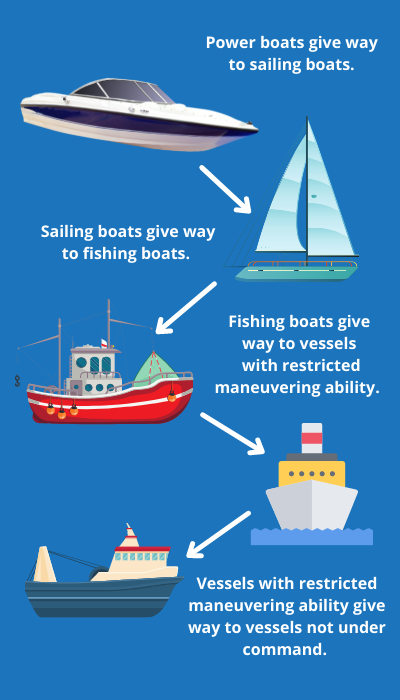It is time for a memorable day on the water! Ensuring you and your group have an awesome water adventure, please make sure to review the rules when encountering another vessel. These are important guidelines to follow, making it safe for your boat as well as other boats on the lake that day.
There are a few terms to familiarize yourself with if you are a new boater.
The Give-Way Vessel: The give-way vessel must yield and get out of the way of the approaching vessel. When two vessels approach one another, it is the give-way vessel's obligation to take early and substantial action to avoid a collision.
The Stand-On Vessel: If you are the Stand-On vessel, it is your responsibility to acknowledge the intended actions of the give-way vessel. You must also maintain your current course and speed until the give-way vessel passes, or you enter a dangerous situation.
Crossing-Paths: Typically, this means you must alter speed or direction to cross behind the other vessel (the stand-on vessel). At night, if you see a red light crossing right-to-left in front of you, you need to change your course. The vessel which has the wind on its starboard (right) side has the right of way. The vessel which has the wind on its port (left) side must give way. When both boats have the wind on the same side the windward (upwind) boat has to give-way.
Meeting a Boat Head-On. As you approach another vessel head-on, make sure to navigate your course starboard. This means you will pass each other on the port side, the side of the vessel to the left of the other vessel. At night, if you see a red light crossing right-to-left in front of you, you need to change your course.
Which Boat has the Right of Way when Crossing Paths? When two vessels are crossing paths, it is vital to know who has the right of way. The stand-on vessel has the right of way, and it is up to the give-way vessel to maneuver in a way that will avoid a collision. You will know this at night if you see the red port light crossing from right to left in front of you. In that case, you are the give-way vessel and should maneuver to avoid collision. If you see the green starboard light crossing from left to right in front of you, you are the stand-on vessel and should continue your course.
What Does it Mean to Overtake another Boat? Any vessel that is approaching your boat for the stern doesn't have the right of way. Maintain your speed and course. The boat who is overtaking is the give-way vessel and should maneuver in a way to avoid collision with the stand-on vessel. Whenever a boat is overtaking another, the vessel in front always has the right of way and should be allowed to continue their original course. At night, the overtaking vessel will see only the white stern light of the vessel being overtaken.
Encountering a Vessel Diagram

The National Maritime College is an excellent resource because they specialize in recreational boat training onboard all types of recreational vessels - large or small, sail or power. This organization provides valuable information for experienced boaters and for boaters trying to improve their handling skills. They advocate for skills-based recreational boat training and aim to equip people with essential boating knowledge, skills and an understanding of the maritime and local State rules.
This knowledge and practical skill plays a crucial role in boating safety and protecting the marine environment.
(Remember to inspect your boat lines and dock ties and replace as needed. Boat lines and dock ties weather and weaken over time.)

